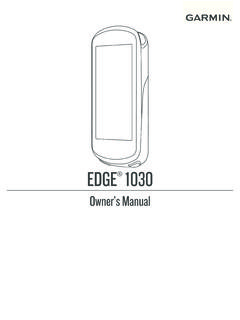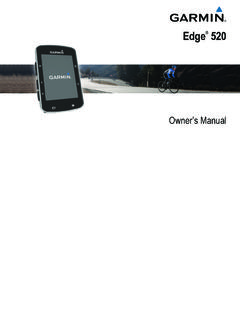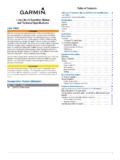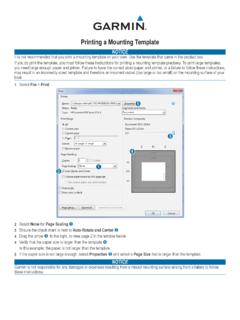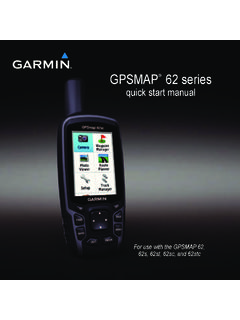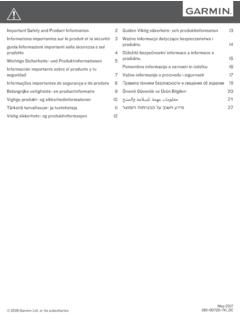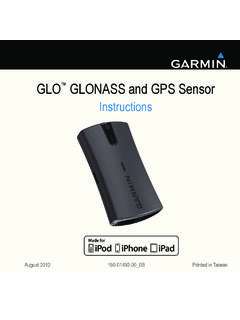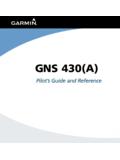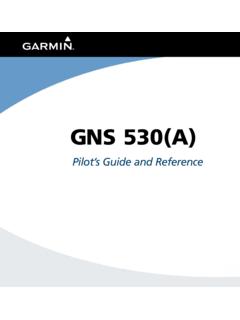Transcription of GHP Reactor • Wrenches • Drill and drill bits Tools …
1 GHP Reactor HydraulicInstallation InstructionsImportant Safety Information WARNINGSee the Important Safety and Product Information guide in the product box for product warnings and other important are responsible for the safe and prudent operation of your vessel. The autopilot is a tool that enhances your capability to operate your boat. It does not relieve you of the responsibility of safely operating your boat. Avoid navigational hazards and never leave the helm be prepared to promptly regain manual control of your to operate the autopilot on calm and hazard-free open caution when operating the autopilot near hazards in the water, such as docks, pilings, and other boats. CAUTIONWhen in use, beware of hot motor and solenoid components and the risk of entrapment from moving to install and maintain this equipment in accordance with these instructions could result in damage or avoid damage to your boat, the autopilot system should be installed by a qualified marine installer.
2 Specific knowledge of hydraulic steering componentry and marine electrical systems is required for proper PreparationThe autopilot system consists of multiple components. You should familiarize yourself with all of the component mounting and connection considerations before beginning installation. You must know how the components operate together in order to correctly plan the installation on your can consult the layout diagrams (Power and Data Layout) to help understand the mounting and connection should lay out all of the components on the boat as you plan the installation to make sure your cables will reach each component. If needed, extension cables (sold separately) for various components are available from your Garmin dealer or from should record the serial number of each component for registration and warranty Needed Safety glasses Drill and Drill bits Wrenches 90 mm ( in.) hole saw or a rotary cutting tool Wire cutters/strippers Phillips and flat screwdrivers Cable ties Waterproof wire connectors (wire nuts) or heat-shrink tubing and a heat gun Marine sealant Marine corrosion inhibitor spray Portable or handheld compass (to test for magnetic interference) Hydraulic hose with machine-crimped or field-replaceable fittings that have a minimum rating of 1000 lbf/in2 Hydraulic T-fittings Inline hydraulic shut-off valves Hydraulic fluid Thread sealant Hydraulic bleeding equipment Anti-seize lubricant (optional)NOTE: Mounting screws are provided for the main components of the autopilot system.
3 If the provided screws are not appropriate for the mounting surface, you must provide the correct types of and Connection ConsiderationsThe autopilot components connect to each other and to power using the included cables. Ensure that the correct cables reach each component and that each component is in an acceptable location before mounting or wiring any Control Mounting ConsiderationsNOTICEThis device should be mounted in a location that is not exposed to extreme temperatures or conditions. The temperature range for this device is listed in the product specifications. Extended exposure to temperatures exceeding the specified temperature range, in storage or operating conditions, may cause device failure. Extreme-temperature-induced damage and related consequences are not covered by the mounting surface must be flat to avoid damaging the device when it is the included hardware and template, you can flush mount the device in the dashboard.
4 If you want to mount the device using an alternative method where it appears flat with the front of the dashboard, you must purchase a flat-mount kit (professional installation recommended) from your Garmin selecting a mounting location, observe these considerations. The mounting location should be at or below eye level to provide optimal viewing as you operate your vessel. The mounting location should allow easy access to the keys on the device. The mounting surface must be strong enough to support the weight of the device and protect it from excessive vibration or shock. To avoid interference with a magnetic compass, the device should not be installed closer to a compass than the compass-safe distance value listed in the product 2015 Printed in Taiwan190-01768-02_0B The area behind the mounting surface must allow room for the routing and connection of the Control Connection Considerations The helm control must connect to the NMEA 2000 network.
5 Optional NMEA 0183 devices, such as wind sensors, water-speed sensors, or GPS devices can be connected to the helm control using a data cable (NMEA 0183 Connection Considerations).CCU Mounting and Connection Considerations The CCU is the primary sensor of the GHP Reactor Hydraulic autopilot system. For best performance, observe these considerations when selecting a mounting location. A handheld compass should be used to test for magnetic interference in the area where the CCU is to be the needle on a handheld compass moves when you hold it where you intend to mount the CCU, magnetic interference is present. You must choose another location and test again. The CCU should be mounted on a rigid surface for best performance. Although the CCU can be installed in any orientation on your boat, you can avoid the step of defining north in the setup procedure by meeting all of these considerations when selecting a mounting location (optional). The connectors on the CCU must point toward the bow.
6 The base of the CCU must be at a right angle to the roll and pitch axis of the boat. The CCU must be located near the center of rotation of the boat, slightly toward the front, if necessary. The CCU cable connects the CCU to the ECU and is 5 m (16 ft.) long. If the CCU cannot be mounted within 5 m (16 ft.) of the ECU, extension cables are available from your local Garmin dealer or at This cable must not be the Best Mounting Location1 Create a list of all suitable mounting locations for the CCU where no iron, magnets, or high-current wires are located within 60 cm (2 ft.).A large magnet, such as a subwoofer-speaker magnet should be no closer than m (5 ft.) to these the center of rotation of the boat, and measure the distance between the center of rotation and each of the suitable mounting locations you listed in step the location closest to the center of more than one location is approximately the same distance from the center of rotation, you should select the location that best meets these considerations.
7 The best location is closest to the centerline of the boat. The best location is lower in the boat. The best location is slightly forward in the Mounting and Connection Considerations The ECU can be mounted on a flat surface, facing any direction. Mounting screws are included with the ECU, but you may need to provide different screws if the supplied screws are not suitable for the mounting surface. The ECU must be located within m (19 in.) of the pump. The cables connecting the ECU to the pump cannot be extended. The ECU must be mounted in a location where it will not be submerged or exposed to wash down. The ECU power cable connects to the boat battery, and it can be extended if needed (Power Cable Extensions).Shadow Drive Mounting ConsiderationsNOTE: The Shadow Drive is a sensor you install in the hydraulic steering lines of your boat. It detects when you manually take control of the helm and suspends autopilot control of the boat. The Shadow Drive must be mounted horizontally and as level as possible, with cable ties firmly securing it in place.
8 The Shadow Drive must be mounted at least 305 mm (12 in.) away from magnetic materials or devices, such as speakers or electric motors. The Shadow Drive should be mounted closer to the helm than to the pump. The Shadow Drive should be mounted lower than the helm, but higher than the pump. The Shadow Drive must not be connected directly to the fitting at the back of the helm. There must be a length of hose between the fitting at the helm and the Shadow Drive. The Shadow Drive must not be connected directly to a hydraulic T-connector in the hydraulic line. There must be a length of hose between a T-connector and the Shadow Drive. In a single-helm installation, there must not be a T-connector between the helm and the Shadow Drive. In a dual-helm installation, the Shadow Drive should be installed between the pump and the hydraulic T-connector that leads to the upper and lower helm, closer to the helm than to the T-connector. The Shadow Drive must be installed in either the starboard steering line or the port steering Shadow Drive must not be installed in either the return line or the high-pressure line, if Mounting and Connection Considerations The alarm should be mounted near the primary helm station.
9 The alarm can be mounted under the dashboard. If needed, the alarm wires can be extended with 28 AWG ( mm2) 2000 Connection Considerations The CCU and the helm control must connect to a NMEA 2000 network. If your boat does not already have a NMEA 2000 network, one can be built using the included NMEA 2000 cables and connectors (Building a Basic NMEA 2000 Network for the Autopilot System). To use the advanced features of the autopilot, optional NMEA 2000 devices, such as a wind sensor, a water-speed sensor, or a GPS device, can be connected to the NMEA 2000 and Data Layout WARNINGWhen connecting the power cable, do not remove the in-line fuse holder. To prevent the possibility of injury or product damage caused by fire or overheating, the appropriate fuse must be in place as indicated in the product specifications. In addition, connecting the power cable without the appropriate fuse in place will void the product Considerations Helm control Helm control data cableThis cable should be installed only if you are connecting the autopilot to optional NMEA 0183 devices, such as a wind sensor, a water-speed sensor, or a GPS device (NMEA 0183 Connection Considerations).
10 NMEA 2000 power cableThis cable should be installed only if you are building a NMEA 2000 network. Do not install this cable if there is an existing NMEA 2000 network on your boat. The NMEA 2000 power cable must be connected to a 9 to 16 Vdc power source. NMEA 2000 networkThe helm control and the CCU must be connected to a NMEA 2000 network using the included T-connectors (NMEA 2000 Connection Considerations).If there is not an existing NMEA 2000 network on your boat, you can build one using the supplied cables and connectors (Building a Basic NMEA 2000 Network for the Autopilot System). ECU CCUThe CCU can be mounted in a non-submerged location near the center of the boat, in any orientation (CCU Mounting and Connection Considerations).The CCU must be located away from sources of magnetic interference. ECU power cableThe ECU must be connected to a 12 to 24 Vdc power source. To extend this cable, use the correct wire gauge (Power Cable Extensions).
